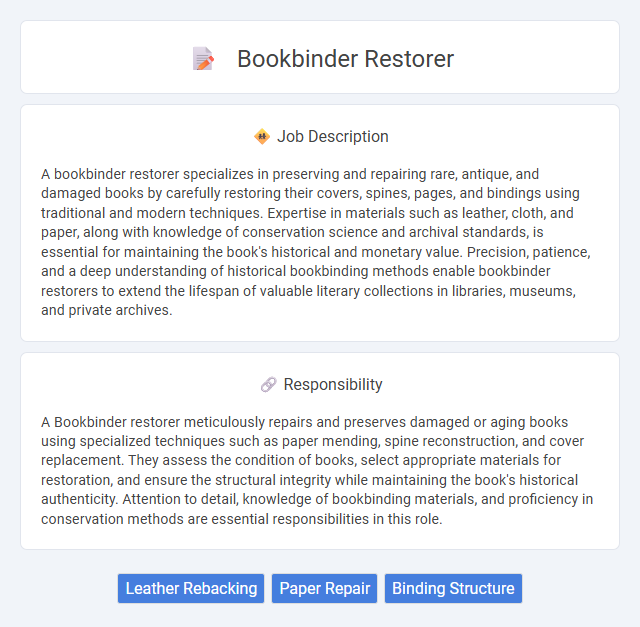
A bookbinder restorer specializes in preserving and repairing rare, antique, and damaged books by carefully restoring their covers, spines, pages, and bindings using traditional and modern techniques. Expertise in materials such as leather, cloth, and paper, along with knowledge of conservation science and archival standards, is essential for maintaining the book's historical and monetary value. Precision, patience, and a deep understanding of historical bookbinding methods enable bookbinder restorers to extend the lifespan of valuable literary collections in libraries, museums, and private archives.
Individuals with strong attention to detail and patience will likely find bookbinder restoration a suitable career, as the job demands meticulous work on delicate materials. People comfortable with prolonged periods of focus and fine motor skill tasks may be more inclined to succeed in this role. Those who struggle with repetitive precision or have difficulty concentrating for extended times might find the job less suitable.
Qualification
A bookbinder restorer requires expertise in historical bookbinding techniques, materials such as leather, vellum, and paper, and knowledge of conservation principles to preserve book integrity. Proficiency in manual dexterity and fine motor skills is essential for tasks like sewing, gluing, and delicate repairs. Formal education or certification in art conservation, library science, or a specialized apprenticeship enhances qualifications for restoring rare and valuable books.
Responsibility
A Bookbinder restorer meticulously repairs and preserves damaged or aging books using specialized techniques such as paper mending, spine reconstruction, and cover replacement. They assess the condition of books, select appropriate materials for restoration, and ensure the structural integrity while maintaining the book's historical authenticity. Attention to detail, knowledge of bookbinding materials, and proficiency in conservation methods are essential responsibilities in this role.
Benefit
A career as a bookbinder restorer may offer unique benefits such as the opportunity to preserve valuable historical and cultural artifacts, which can provide a deep sense of fulfillment and purpose. There is a probability of working in diverse environments, from museums and libraries to private collections, fostering a rich professional experience. The specialized skills acquired could lead to steady demand in niche markets, potentially resulting in job stability and opportunities for artistic expression.
Challenge
Bookbinder restorers likely face the challenge of delicately handling fragile materials that have aged or deteriorated over time, requiring precision and patience. The complexity of matching original techniques and materials could present difficulties in maintaining the authenticity and integrity of the book. Working within the constraints of preservation standards might increase the probability of encountering intricate and time-consuming restoration problems.
Career Advancement
Bookbinder restorers develop specialized skills in repairing and preserving rare and valuable books, increasing their expertise through advanced techniques like leather tooling and archival conservation. Mastery in historic book restoration can lead to leadership roles in museums, libraries, or private collections, where they oversee preservation projects and mentor junior restorers. Continued education and certification in conservation sciences significantly enhance career growth opportunities and access to high-profile restoration assignments.
Key Terms
Leather Rebacking
Leather rebacking is a specialized bookbinder restorer technique involving the replacement or reinforcement of a book's spine leather to enhance durability and preserve its original aesthetic. Precision in selecting compatible leather materials and using archival adhesives ensures structural integrity while maintaining historical authenticity. This process significantly extends the lifespan of rare and antique books by protecting the joints and allowing the book to open and close smoothly.
Paper Repair
Expertise in paper repair is essential for a bookbinder restorer, involving meticulous techniques to mend tears, reinforce weakened pages, and remove stains without compromising the paper's integrity. Using archival-quality materials and adhesives, professionals stabilize fragile documents to extend their lifespan and preserve historical value. Mastery of these skills ensures delicate manuscripts and rare books retain their original appearance and functionality.
Binding Structure
A Bookbinder restorer specializes in repairing and preserving the binding structure of books, ensuring durability and longevity while maintaining historical accuracy. They use techniques such as spine reinforcement, re-sewing signatures, and replacing or restoring covers with materials that match the original craftsmanship. Their expertise helps prevent further deterioration, supporting both functional use and archival preservation of rare and valuable volumes.
 kuljobs.com
kuljobs.com